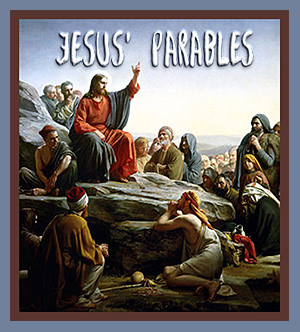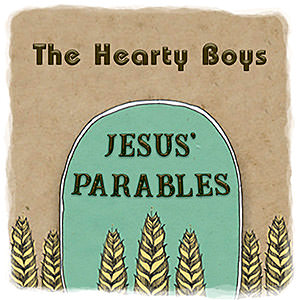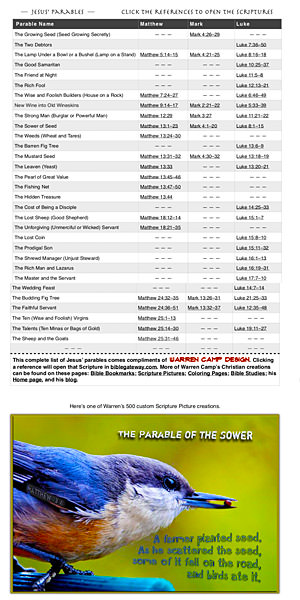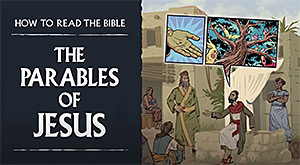A parable is a literary tool used throughout the Bible. Jesus himself used this method frequently.
His parables are effective teaching aids that compare two things or concepts. The word “parable” (Gr. “parabole” = placing beside) signifies a comparison between two objects. Thus, a parable may contain one main word that’s used to mirror a related concept or object.
A common description of a parable is “an earthly story with a heavenly meaning.” Generally speaking, a parable is a fictitious tale that’s usually realistic. The normal purpose of Jesus’ parables was to convey a spiritual truth.
The undisputed greatest storyteller!
Jesus of Nazareth told many parables; for a time in his ministry, he relied heavily on story-telling: “He did not say anything to them without using a parable” (Mark 4:34). He knew that everyone loved to hear stories. It’s easy to see from Mark’s gospel, for example, that Jesus had used stories in his communications with everyday people to help them see the world more clearly so they could see and clearly understand the Lord who loved them.
It was an easy way to get people to think — maybe even change their ways — without being too preachy.
One of the more interesting aspects of the New Testament are the parables of Jesus, as recorded in the gospels of Matthew, Mark and Luke. John didn’t record any parables.
Jesus often taught using parables because they were easy to understand and related to everyday life.
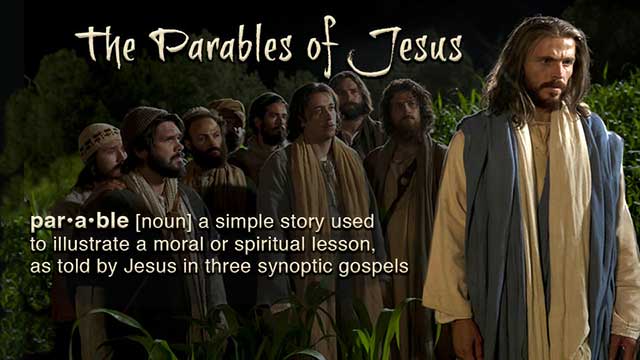
Discover the Parables of Jesus
Why Did Jesus Speak in Parables?
Of all the parables in the Bible, Jesus Christ himself made the greatest use of this literary device. We can only imagine the wonder of his drawing from real-life issues of agriculture, justice, greed, stewardship, finance, and love so he could effectively capture each crowd’s attention. Yet, despite their simplicity, his stories were filled with eternal, spiritual truths.
In this list are all of Jesus’ parables, put into five distinct groups. There’s also a downloadable list (below-right) of all 44 of Jesus parables that has links to the Scriptures for each parable.
Selected Parables in Five Groups
1. — “Kingdom” Parables Study Materials
a. The Sower, Seed, and Soil: Read Matthew 13:1–23; listen to this parable’s recitation; read Warren’s summary; watch its video clip.
b. Weeds — The Work of the Enemy: Read Matthew 13:24–43; listen to this parable’s recitation; read Warren’s summary; watch its two video clips.
c. Hidden Treasure, Valuable Pearl: Read Matthew 13:44–46; listen to this parable’s recitation; read Warren’s summary; watch its video clip.
d. The Fishing Net, Household Treasures: Read Matthew 13:47–52; listen to this parable’s recitation; read Warren’s summary; watch its two video clips.
e. The Mustard Seed and Yeast: Read Matthew 13:31–33; Mark 4:30–32; Luke 13:18–21; listen to this parable’s recitation; read Warren’s summary; watch its video clip.
f. The Cost of Discipleship: Read Matthew 16:24–27; Mark 8:34–38; Luke 9:23–26; 14:25–33 listen to this parable’s recitation; read Warren’s summary; watch its video clip.
g. The Ten Minas: Read Luke 19:11–27; listen to this parable’s recitation; read Warren’s summary; watch its video clip.
h. The Strong Man: Read Matthew 12:22–37; Mark 3:22–29; Luke 11:14–23; listen to this parable’s recitation; read Warren’s summary; watch its video clip.
i. The Growing Seed: Read Mark 4:26–29; listen to this parable’s recitation; read Warren’s summary; watch its video clip.
j. Mourning for the Bridegroom; Patching an Old Garment; Pouring Wine into Wineskins: Read Matthew 9:14–17; Mark 2:18–22; Luke 5:33–39; listen to this parable’s recitation; read Warren’s summary.
2. — “Salvation” Parables Study Materials
a. A Lost Sheep; a Lost Coin; a Lost Son: Read Matthew 18:10–14; Luke 15:1–32; listen to this parable’s recitation; read Warren’s summary; watch three video clips.
b. Workers in the Vineyard: Read Matthew 20:1–16; listen to this parable’s recitation; read Warren’s summary; watch its video clip.
c. The Wedding Banquet: Read Matthew 22:1–14; listen to this parable’s recitation; read Martin Luther’s sermon; read Warren’s summary; watch its video clip.
d. The Narrow Door of Salvation: Read Matthew 7:13-14; Luke 13:22–30; listen to this parable’s recitation; read Warren’s summary; watch its video clip.
e. The Pharisee and the Tax Collector: Read Luke 18:9–14; listen to this parable’s recitation; read Warren’s summary; watch its video clip.
3. — “Wisdom and Folly” Parables Study Materials
a. Ten Virgins (or Bridesmaids): Read Matthew 25:1–13; listen to this parable’s recitation; read Warren’s summary; watch its video clip.
b. The Rich Fool: Read Luke 12:13–21; listen to this parable’s recitation; read Warren’s summary; watch its video clip.
c. The Shrewd Manager (or Unjust Steward): Read Luke 16:1–15; listen to this parable’s recitation; read Martin Luther’s sermon; read Warren’s summary; watch its video clip.
d. Wise and Foolish Builders: Read Matthew 7:24–27; Luke 6:46–49; listen to this parable’s recitation; read Warren’s summary; watch its video clip.
e. The Budding Fig Tree: Read Matthew 24:32–35; Mark 13:28–31; Luke 21:25–33; listen to this parable’s recitations (Matthew 24, Mark 13, and Luke 21); read Warren’s summary; watch its video clip.
New! f. Watchful Servants: Read Matthew 24:42–51; Luke 12:35–48; Mark 13:34–37; listen to this parable’s recitation; read Warren’s summary; watch its video clip.
4. — “Christian Life” Parables Study Materials
a. A Tale of Two Sons: Read Matthew 21:28–32; listen to this parable’s recitation; read Warren’s summary; watch its video clip.
b. Two Stories About Lamps: Read Matthew 5:14–16; Mark 4:21–25; Luke 8:16–18; 11:33–36; listen to the parables’ recitations (Matthew 5, Mark 4, Luke 8; and Luke 11); read Warren’s summary; watch its video clip.
c. The Good Samaritan: Read Luke 10:25–37; listen to this parable’s recitation; read Warren’s summary; watch its video clip.
d. Friend at Midnight, Persistent Widow: Read Luke 11:5–13; 18:1–8; listen to both parables’ recitations (chapter 11’s and chapter 18’s); read Warren’s summary; watch its video clip.
e. Two Debtors: Read Luke 7:36–50; listen to this parable’s recitation; read Warren’s summary; watch its video clip.
f. Blind, Leading the Blind: Read Matthew 15:13–14; Luke 6:37–40; listen to the parables’ recitations (Matthew 15, Luke 6); read Warren’s summary.
New! g. Servant and Master: Read Luke 17:7–10; listen to the parables’ recitation (Luke 17); read Warren’s summary; watch its video clip.
5. — “Judgment” Parables Study Materials
a. An Unforgiving Servant: Read Matthew 18:21–35; listen to this parable’s recitation; read Martin Luther’s sermon; read Warren’s summary; watch its video clip.
b. The Wicked Trustees/Tenants: Read Matthew 21:33–46; Mark 12:1–12; Luke 20:9–19; listen to this parable’s recitation; read Warren’s summary; watch its video clip.
c. Bags of Gold (Talents): Read Matthew 25:14–30; listen to this parable’s recitation; read Warren’s summary; watch its video clip.
d. The Rich Man and Lazarus: Read Luke 16:19–31; listen to this parable’s recitation; read Warren’s summary; watch its video clip; and take this fill-in quiz.
e. Sheep and Goats: Read Matthew 25:31–46; listen to this parable’s recitation; read Warren’s summary; watch its video clip.
f. The Great Banquet: Read Luke 14:15–24; listen to this parable’s recitation; read Warren’s summary; watch its video clip.
g. The Barren Fig Tree: Read Luke 13:6–9; listen to this parable’s recitation; read Warren’s summary; watch its video clip.
h. The People of This Generation: Read Matthew 11:13-24; Luke 7:31–35; listen to this parable’s recitation; read Warren’s summary.
New! i. The Exalted/Humbled Dinner Guests: Read Luke 14:1, 7–14; listen to this parable’s recitation; read Warren’s summary; watch its video clip.

